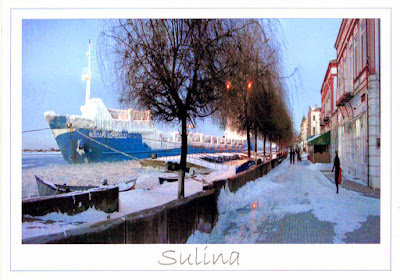 |
| 1612 Sulina - Waterfront in winter |
Located in Danube Delta, at the point where the Sulina branch of the Danube flows in the Black Sea, the town and free port Sulina is the easternmost point of Romania. It is not linked directly to the road network of Romania and can be reached only by water, either via the Danube or via the Black Sea. There is a theory according to which Sulina had been founded in 7th century BC by Cimmerians and developed together with the advent of the first Greek colonies on the shores of Pontus Euxinus. Anyway, during the mid-Byzantine period Sulina was a small cove and in 14th century a Genoese port inhabited by a handful of sailors, pirates and fishermen. In 18th century the Ottomans built a lighthouse there in order to accommodate communication between Constantinople (Istanbul) and the Danubian Principalities, the main breadbaskets for the Ottoman capital.
 |
| 1613 Sulina - Hotel Camberi at the beginning of the 20th century (now, the hotel is a ruin) |
In 1800, Sulina have 8722 inhabitants and was a cosmopolitan settlement, being formed in equal measure from Romanians, Turks, Greeks, Armenians, Jews, Russians and Italians, reason why the writer Jean Bart, former captain of the port of Sulina, called it Europolis in his most important novel. Thanks to the Treaty of Adrianople, since 1829, that unfettered the Danube grain trade, Sulina, by then under Russian control, became important. Great sailing boats couldn't sail fully loaded to Brăila and Galaţi, which were the main export centres of Wallachia and Moldavia, because of the shallow waters of the river; therefore, they had to tranship at least part of their cargoes to smaller riverboats (shleps). The owners and crew of these sleps were almost always Greek.
Read more »

